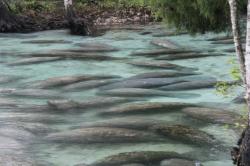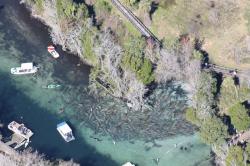The Florida Manatee–A Conservation Success Story
By Frank Sargeant, Editor
from The Fishing Wire
The restoration of the Florida manatee is a remarkable conservation success story, though you wouldn’t know it from news reports that continue to bemoan the “disappearing manatee”.
The Florida manatee is a conservation success story, with numbers growing to at least 10 times today what they were in the 1970’s thanks to strong support for rules designed to protect them. (Photo Credit Florida FWCC)From a population roughly-estimated at somewhere around 600 in the 1970’s, the numbers have rebounded to a robust 6,000 or more in 2015, a stunning turnaround. This is particularly so considering that in those years the Sunshine State grew from largely rural, with a population of only about 4 million humans, to almost 20 million in a largely urban environment today.
Close to a million boats ply the waters today, many times the number of the 1970’s, and yet there are at least 10 times the numbers of manatees today that there were 50 years ago.
Manatee conservation clubs, which depend on a disappearing manatee population for funding, pretty much turn themselves inside out to explain how the surveys conducted since the first in January 1991, when there were 1267 counted, to Feb. of 2015, when there were 6063, can be construed as showing anything other than a dramatic increase in populations on both coasts of the state.
Experience on the water bears out the increases–when I first moved to Florida in 1966, I spent nearly a year on the water before I saw my first manatee. Today, it’s difficult to go anywhere on inside waters in the southern half of the state without seeing a half dozen and sometimes many more. This is the experience of virtually all knowledgeable skippers who run in areas where manatees are common.
It’s clear evidence of the potential success of wise conservation policies and regulations, adequately enforced. Boaters and anglers have more than done their part in this restoration–admittedly after a fair amount of bitching and whining. Early on, many of us in the industry felt that laws were placing excessive burdens on the recreational boater and angler, with thousands of acres of water set aside in areas where manatees rarely or never were seen.
Signs like this now mark hundreds of areas where boaters are required to proceed at low speed, while many other areas are off limits to boaters completely. (Frank Sargeant photo)Be that as it may, the broad strokes approach, combined with the persuasive power of Jimmy Buffet and throngs of Parrotheads worked. Thousands of acres of manatee slow speed zones and even no-entry zones are now enforced statewide, and manatee populations are booming. Boaters and anglers, with occasional prodding from the men in the gray suits, respect these zones and enjoy observing the giant “sea cows” more often and at closer range than the many ashore who frequently charge said mariners with being the source of the non-existent population decline.
However, there’s no question that more manatees are dying than need be, and boaters are responsible for a part of those deaths–about 18 to 21 percent in average years. The trend is headed downward, but it’s possible more can be done on our part to secure the gains.
I was fortunate to live for some 20 years on the aptly-named Little Manatee River, where I saw manatees, both little and big, pretty much every day. Some became more or less regular visitors to my dock, passing on the same phase of the tide daily for weeks at a time. One I called Sundown Sam often showed up just before dark, and shared many a philosophical conversation with me. He was a good listener, much cheaper than a psychiatrist, and did not expect tips like a barkeep. (I had suspicions he hung around more because of the leaky freshwater hose on the cleaning table than because of my scintillating speculations and cosmic whinings, but nonetheless he was there for me.)
 In winter manatees gather by the dozens and sometimes by the hundreds in warm water refuges around the state. (Photo Credit Florida FWCC)
In winter manatees gather by the dozens and sometimes by the hundreds in warm water refuges around the state. (Photo Credit Florida FWCC)
Manatees are not nearly so wild as most terrestrial animals because they have survived for generations without being hunted by humans–they tolerate us well. I watched them feed their young, fight for mating rights (surprisingly violent for the alleged “gentle giants” of the media) and die: from cold, red tide, old age–and yes, on rare occasions, from boat strikes. They are fascinating, improbable animals that seem like they should live in Africa or South America, yet right there they are in Ruskin surrounded by tourists and tomatoes, and all over the southern half of the state, a reminder from Florida’s past of what it was before it became what it is.
The percentage of manatees killed by boat strikes as a percent of the live population has declined steadily for the last 10 years, but the percent of the annual observed mortality, as counted by the FFWCC, has remained fairly flat.
In 2006, 92 of 417 deaths recorded by the FFWCC were the apparent result of boat or propeller strikes, about 22 percent. It was 23 percent in 2007, 27 percent in 2008, 23 percent in 2009.
The 2010 count was an anomaly because of a huge cold kill, with a total of 766 animals dying, so the percentage of boat strike deaths, 83, was artificially low at 11 percent.
In 2011 it was 88 of 451 for 19 percent, in 2012 82 or 392 for 21 percent.
2013 was another untypical year, with 830 animals dying, most from red tide and from pollution in Broward County waters, putting the boating toll of 73 at only 8 percent.
In 2014 the number was 69 of 371, the lowest in recent years, for 18 percent. This year the number has jumped again, as of Dec. 1, to 83 of 383, which if the average holds and there’s no ice storm or massive red tide invasion before year’s end, will be 23 percent. While the percentages are not changing much, manatee overall counts have been climbing steadily in those years, more than doubling. This would appear to mean that boaters are doing a much better job of avoiding collisions with far more abundant animals.
Though manatees are huge animals, it can sometimes be difficult to see them, particularly when only their nostrils are showing above the surface. (Photo Credit Florida FWCC)Clearly boaters are no longer the major problem in manatee mortality–in fact, it’s not even close. And manatees are obviously not endangered–they are more likely approaching what biologists call the carrying capacity of their very limited habitat, the narrow grass flats, estuaries and coastal rivers of Florida. They aren’t making any more manatee pastures, but the manatees are definitely continuing to make more manatees.
While the rules of wildlife biology may somehow magically suspend in the case of manatees, in all other species there is a clear, definable limit to the populations–when they eat all the available food, fertility begins to fall, natural mortality increases and the numbers go down–sometimes precipitously if the animals have consumed all the available forage down to the point where re-growth is impossible or takes longer than a season.
Be that as it may, more can be done to lower our part in manatee mortality.
No one better knows where manatees roam than flats angler who spend a lot of time on the water. It’s my experience that the animals often lay up in water 3 to 4 feet deep when resting, and that they use these areas at certain hours nearly every day of a given season–if you know of one of these locations, make your local FWC officers aware of it–and stay clear.
Secondly, of course, learn to see them–for an animal that can weigh over a half-ton, they can be surprisingly invisible at times, particularly when resting. The greatest danger is on the edge of the grass flats, where the animals frequently settle on bottom to sleep. Unmoving, they look like another patch of dark grass in many water conditions and sun angles.
All the well-publicized cautions are also good prevention:
Slow down in areas where you know manatees reside or pass, even if they are not marked manatee zones.
Watch for the boiling swirl, the size of a bath tub, that marks where a manatee tail is powering one of them along bottom.
Keep an eye out for manatee noses ahead–often, they show only a patch of gray skin and nostrils the size of a teacup as they pop up to breath.
This incredible aerial shot shows the winter massing of several hundred manatees at Three Sisters Spring—there are numerous warm-water refuges like this around the state where the animals gather in cold weather, making counts easier. (Photo credit Florida FWCC)
Always wear polarized sunglasses when operating in manatee waters–they allow you to see through the glare and spot the animals well in advance.
Be aware of manatee movements by season–in winter, hundreds swarm into warm-water sanctuaries like spring outflows and power-plant cooling channels, but they come out daily to feed on nearby flats.
Stay at least 50 feet away from observable manatees. Be aware that there may be other manatees that you do not see close to those you do–operating the outboard can injure these animals.
NO MOTOR ZONES ARE GOOD–SOMETIMES
When Florida first started establishing no-motor zones to protect sea grasses and manatees, boaters and anglers howled (I was among them) because they felt it was restricting their access to thousands of acres of prime fishing. And in a few cases, they were right–the zones were too big, covering a lot of area where manatees were never present, and sometimes in the wrong place to do much good.
But, surprise, no motor zones have another very dramatic effect that benefits anglers–the trout, snook, reds, sheepshead and flounder that are often run off the flats by boats zipping by on plane in 1 to 3 feet of water settle in and become resident in areas where anglers have to enter slowly and quietly by pushpole, paddle or trolling motor.
And their habitat is not being torn up by churning props. The fish move in predictable patterns, they spawn more successfully and their young survive to grow up more frequently. It’s a win for fish, manatees, sea grass and for anglers–in the right places and within reasonable limits, no motor zones are good–very good.
AND FINALLY
In our quest to leave the planet a better place than we found it–one common goal I hope all of us can still agree to in this now sadly-divided country–the manatee restoration marks a milestone. Let’s not guilt ourselves into making it a disaster. Let’s proclaim victory–and not accept it when we hear media reports that begin “With only a few manatees remaining . . . .” or “The disappearing manatee population. . . .” We have done our part. Now let’s call on the media and everyone else to do theirs.
* If you hit a manatee while boating, notifying the FFWCC immediately may give the animal a chance to survive. Here are the contacts:
1-888-404-FWCC (3922)
Cellular phone *FWC or #FWC
http://www.myfwc.com/contact/wildlife-alert/



